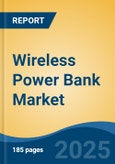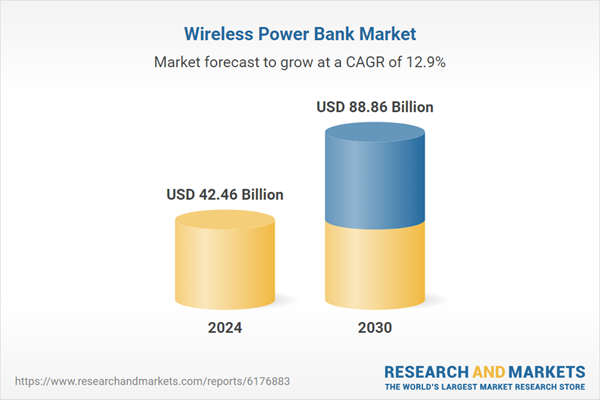Speak directly to the analyst to clarify any post sales queries you may have.
10% Free customizationThis report comes with 10% free customization, enabling you to add data that meets your specific business needs.
The Wireless Power Bank Market refers to the segment of portable energy storage devices that provide wireless charging capabilities to electronic gadgets, primarily through inductive charging technologies such as Qi standard. These devices eliminate the need for physical cables, offering greater convenience and flexibility for users of smartphones, tablets, smartwatches, and other compatible devices. The market is witnessing robust growth due to increasing dependence on mobile devices, rising consumer preference for clutter-free charging solutions, and technological advancements that have improved wireless power transfer efficiency and battery capacity.
Additionally, the growing trend of remote working and on-the-go lifestyles has heightened the demand for reliable, portable charging options. Major smartphone manufacturers incorporating wireless charging features across mid-range and premium devices have further catalyzed the adoption of wireless power banks. Furthermore, the market is supported by innovations such as fast charging, multi-device support, USB-C integration, and power delivery technology, which are enhancing the user experience and expanding use cases. Environmental sustainability is also playing a pivotal role, with several manufacturers focusing on recyclable materials and energy-efficient designs.
E-commerce channels have significantly boosted market penetration, offering consumers easy access to a wide range of wireless power bank products globally. Geographically, Asia Pacific dominates the market owing to the region’s large consumer electronics base, expanding middle-class population, and rapid urbanization. North America and Europe follow closely due to high smartphone penetration and early adoption of wireless technologies. Despite the relatively higher cost compared to traditional wired power banks, consumer willingness to invest in premium, hassle-free charging solutions is pushing market boundaries.
Key Market Drivers
Surging Demand for Portable Consumer Electronics Fuels Wireless Power Bank Market Growth
The escalating demand for portable consumer electronics, such as smartphones, tablets, smartwatches, and wireless earbuds, is a primary driver of the Wireless Power Bank Market, as these devices require convenient and efficient charging solutions to support their widespread use. The proliferation of mobile devices has transformed how consumers communicate, work, and entertain, with smartphones alone becoming indispensable for daily tasks. Wireless power banks address the need for on-the-go charging by offering cable-free convenience, enabling users to charge devices seamlessly during travel, outdoor activities, or daily commutes.Advancements in wireless charging technologies, such as Qi and MagSafe, have enhanced compatibility and charging efficiency, making wireless power banks a preferred choice for tech-savvy consumers. The rise of 5G-enabled devices, which consume more power due to higher data speeds, further amplifies the need for reliable portable charging solutions. As consumer reliance on electronics grows, manufacturers are innovating to produce compact, high-capacity wireless power banks with features like multi-device charging and fast-charging capabilities.
The global trend toward digitalization, coupled with increasing smartphone penetration in emerging markets like India and Africa, drives the demand for wireless power banks. Additionally, the shift toward remote work and digital nomadism has increased the need for portable power solutions to keep devices operational without access to traditional power sources. Retail and e-commerce platforms are capitalizing on this trend by offering a wide range of wireless power banks, catering to diverse consumer preferences for design, capacity, and functionality. The Wireless Power Bank Market is poised for sustained growth as consumers prioritize convenience, portability, and compatibility in their charging solutions, aligning with the expanding ecosystem of smart devices.
According to the International Data Corporation, global smartphone shipments reached 1.38 billion units in 2023, with a 3.2% year-over-year growth, underscoring the increasing reliance on mobile devices and the need for portable charging solutions like wireless power banks.
Key Market Challenges
High Cost of Production and Premium Pricing Structure
One of the foremost challenges restraining the widespread adoption of wireless power banks is the significantly high cost associated with their manufacturing, which subsequently results in premium pricing for end consumers. Unlike traditional wired power banks, wireless variants require advanced inductive charging components, electromagnetic shielding, smart heat management systems, and enhanced circuit designs. The integration of these advanced components directly contributes to elevated production costs. In addition, to ensure compatibility with various devices, manufacturers must incorporate multi-standard wireless charging capabilities such as the Qi standard, which demands additional testing and certification further driving up operational expenditures.The premium pricing structure of wireless power banks consequently limits their adoption among price-sensitive consumer segments, particularly in emerging economies. While early adopters and tech-savvy consumers in developed regions are more likely to invest in wireless charging solutions, the mainstream population continues to favor more affordable wired alternatives. This cost disparity presents a considerable barrier to market penetration. Furthermore, original equipment manufacturers aiming to offer value-added wireless charging solutions face the challenge of balancing innovation with profitability while remaining competitive in a saturated power bank market.
Moreover, the price-performance ratio is another factor that dampens consumer interest. Users often compare wireless power banks to their wired counterparts in terms of charging efficiency, speed, and capacity. If the wireless solution fails to offer comparable performance for its higher price, customer retention and repeat purchases may decline. Businesses in this segment are therefore compelled to invest heavily in research and development while maintaining competitive pricing - a dual challenge that can strain financial and operational resources. Thus, unless advancements in wireless charging technology significantly reduce costs and enhance efficiency, the high cost of production and premium pricing will continue to constrain the market's broader growth potential.
Key Market Trends
Rapid Advancements in Qi2.2 and High-Speed Wireless Charging
A pivotal trend transforming the wireless power bank market is the accelerated adoption of the new Qi 2.2 wireless charging standard, which enables output speeds up to 25 watts, rising from Qi 2’s previous 15 watts limitation. Major industry players such as Ugreen, Belkin, Baseus, Anker, Aukey, Scosche, and others have already secured Qi 2.2 certifications for upcoming products - including MagFlow-branded power banks and multi-device charging docks signaling a significant upgrade in performance capabilities.This evolution is expected to catalyze broader consumer adoption, particularly among users who demand wireless charging experiences comparable to wired devices. As more smartphones especially Apple’s iPhone 17 and certain Android models - support Qi 2.2, consumer compatibility increases, thereby enhancing the utility and attractiveness of wireless power banks. In response to this standard shift, manufacturers are investing heavily in R&D to integrate magnetic alignment technologies, foreign object detection, and dynamic power delivery into their products. This trend is anticipated to accelerate market growth, reinforce product differentiation, and elevate the user experience through significantly faster wireless charging.
Key Market Players
- Anker Innovations Technology Co., Ltd.
- Xiaomi Corporation
- Samsung Electronics Co., Ltd.
- Belkin International, Inc.
- RAVPower (a brand of Sunvalley Group)
- ROMOSS Technology Co., Ltd.
- Aukey Technology Co., Ltd.
- Lenovo Group Limited
- Omnicharge, Inc
- Morphie Powerstation
Report Scope:
In this report, the Global Wireless Power Bank Market has been segmented into the following categories, in addition to the industry trends which have also been detailed below:Wireless Power Bank Market, By Battery Type:
- Lithium-Ion
- Lithium-Polymer
Wireless Power Bank Market, By Technology:
- Inductive Charging
- Magnetic Resonance Charging
- Radio Frequency-Based Charging
Wireless Power Bank Market, By End-User:
- Personal
- Commercial
- Industrial
Wireless Power Bank Market, By Region:
- North America
- United States
- Canada
- Mexico
- Europe
- Germany
- France
- United Kingdom
- Italy
- Spain
- South America
- Brazil
- Argentina
- Colombia
- Asia-Pacific
- China
- India
- Japan
- South Korea
- Australia
- Middle East & Africa
- Saudi Arabia
- UAE
- South Africa
Competitive Landscape
Company Profiles: Detailed analysis of the major companies present in the Global Wireless Power Bank Market.Available Customizations:
With the given market data, the publisher offers customizations according to a company's specific needs. The following customization options are available for the report.Company Information
- Detailed analysis and profiling of additional market players (up to five).
This product will be delivered within 1-3 business days.
Table of Contents
Companies Mentioned
- Anker Innovations Technology Co., Ltd.
- Xiaomi Corporation
- Samsung Electronics Co., Ltd.
- Belkin International, Inc.
- RAVPower (a brand of Sunvalley Group)
- ROMOSS Technology Co., Ltd.
- Aukey Technology Co., Ltd.
- Lenovo Group Limited
- Omnicharge, Inc
- Morphie Powerstation
Table Information
| Report Attribute | Details |
|---|---|
| No. of Pages | 185 |
| Published | September 2025 |
| Forecast Period | 2024 - 2030 |
| Estimated Market Value ( USD | $ 42.46 Billion |
| Forecasted Market Value ( USD | $ 88.86 Billion |
| Compound Annual Growth Rate | 12.9% |
| Regions Covered | Global |
| No. of Companies Mentioned | 10 |









